Toshiba KIRAbook Ultrabook Review
by Dustin Sklavos on May 9, 2013 12:01 AM ESTSystem Performance
The Toshiba KIRAbook may be using the current "entry level" low voltage Intel Core i7, but it's still an extremely fast processor. The Ivy Bridge-based i7-3537U features a nominal 2GHz clock speed and is able to turbo up to 2.9GHz on both cores or even 3.1GHz on a single core, power and thermals depending. The HD 4000 graphics are also able to jump to 1.2GHz, but that advantage is likely to be much more modest. Finally, the SSD in the KIRAbook is a very capable one and should help it out in PCMark.
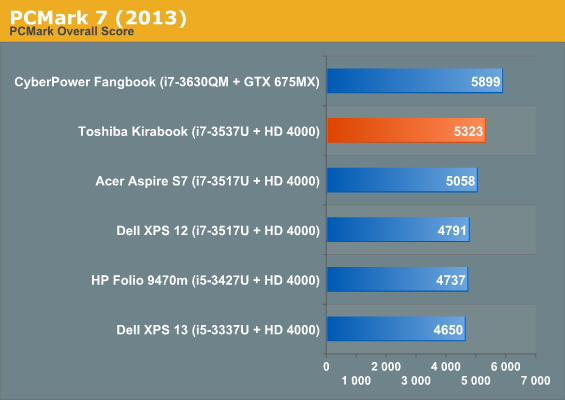
PCMark 7's leanings towards SSDs are essentially correct; as a whole, the i7-3537U in the KIRAbook is faster than any of the other ultrabooks tested, and the SSD is definitely snappy. It's remarkable that the vastly more powerful CyberPower Fangbook (which includes a 256GB Samsung 840 Pro) doesn't bludgeon the KIRAbook harder.
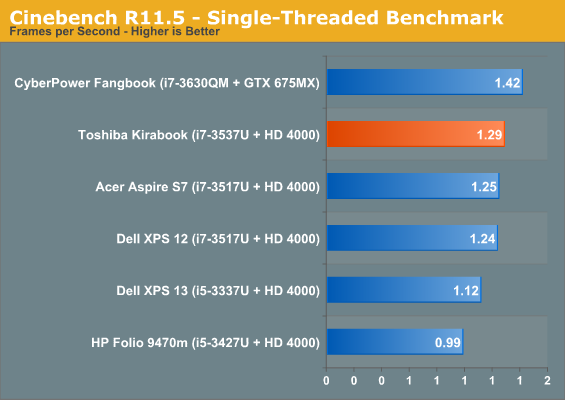
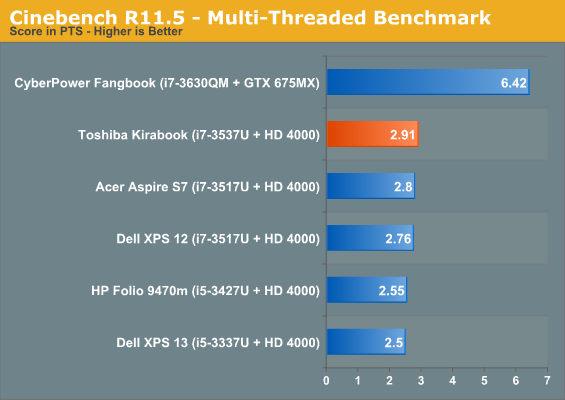

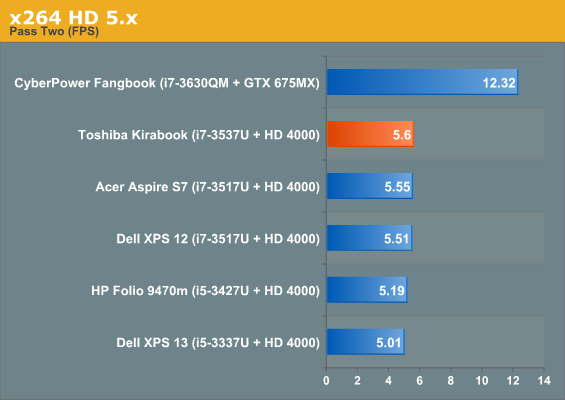
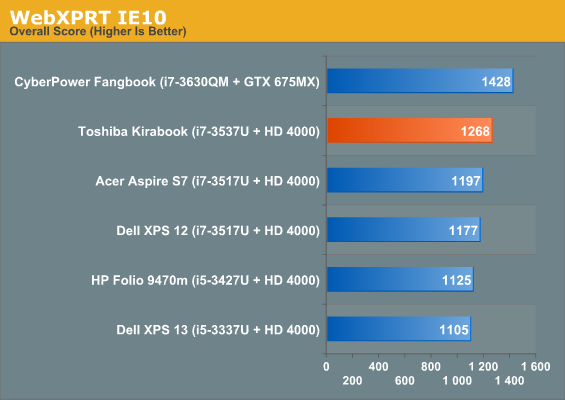
CPU-centric benchmarks are also mostly in the KIRAbook's favor, but the first pass in x264 isn't as strong as it ought to be. The entry KIRAbook will be equipped with the same CPU as the Dell XPS 13 in these charts, so you're looking at a measurable decrease in CPU performance going that route. If the extra $400 for the upgrade to our review unit meant more than just Windows 8 Pro, a touchscreen, and the i7-3537U it might be easier to justify, but the i5-3337U is still a totally serviceable CPU.
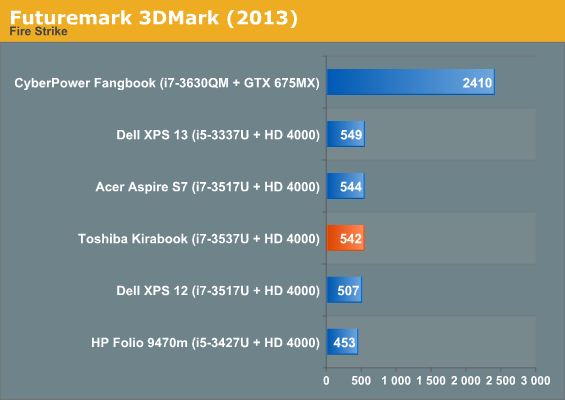
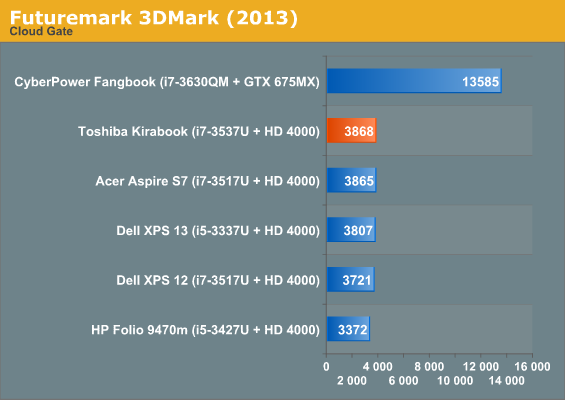
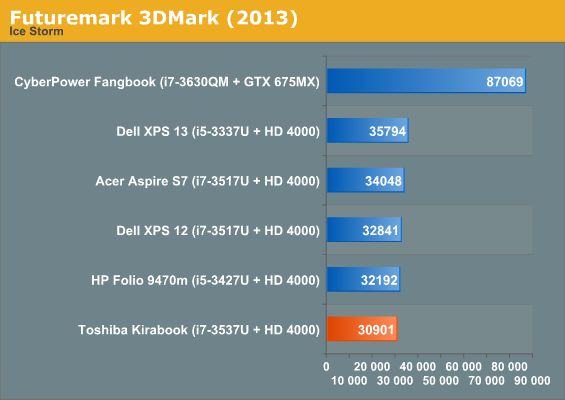
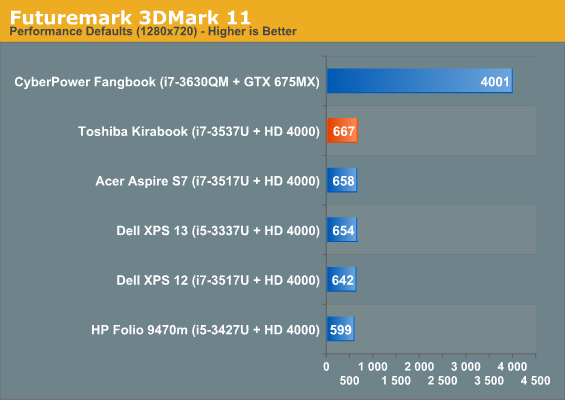
3DMark performance of the KIRAbook is pretty much par for the course; any differences between the ultrabooks listed can probably be chalked up to thermal design differences between individual chassis rather than differences in the CPUs themselves.










110 Comments
View All Comments
wanderer000 - Sunday, May 26, 2013 - link
Why does a laptop need to have things hanging out of it to achieve 5Ghz? It's all internal.......wanderer000 - Sunday, May 26, 2013 - link
Whoops just ignore me, your comment confused me on first read.madmilk - Saturday, May 11, 2013 - link
They're not the one manufacturer that finally made a laptop with a good screen. They're the second, following Apple, and in any case being first doesn't mean no other standards apply. For comparison: the $1500 rMBP comes with a dual-band, 3x3 802.11n adapter, and that really should be the norm for a laptop of that price.Dalamar6 - Monday, May 13, 2013 - link
They aren't the 2nd to use a "good screen" by far. They're the second to use one this good that's higher res than 1920x1200.In any case, I do not see the point to using such a high res screen on less than a 20" notebook, or at the very least, 17". 1080p pixel pitch is TINY on 15.6" already.
I wouldn't buy this... that much money's better spent on an IPS screen laptop elsewhere.
ShieTar - Tuesday, May 14, 2013 - link
Actually, the tiny resolution does make sense, because it makes texts and other fine details more readable if the software offers reasonable scaling. Which any office suite, web browser and a lot of other productive stuff do.When you view videos or play games, resolution becomes less relevant. Nevertheless, if the HD4000 is too weak to play the full resolution, it is nice to be able to use half resolution without major resampling artifacts. That actually works fine with the 1440p screen scaled to 720p, which is a design resolution for most modern games anyways, but you won't be able to scale anything modern to 960x540 and still enjoy it.
Alternatively, you can try to play the full resolution an just switch of any kind of AA, as you basically get a biological AA due to the sub-visible pixel size.
wanderer000 - Sunday, May 26, 2013 - link
It is when it costs an arm and a leg.JoseAntinio - Friday, May 10, 2013 - link
Hi I'm new here and would appreciate some advice.My understanding is that 2.4GHz Vs 5GHz have both plus and minuses and many believe that 2.4GHz is a better option for the home user.
If I am right there are no speed issues, in fact as I understand it 2.4GHz can run quicker.
Could it be that Toshiba have actually got it right for the target market?
hp79 - Friday, May 10, 2013 - link
Yup, both plus and minus. I use both at home. 2.4GHz is too crowded these days especially if you live in an apartment. That's when 5GHz does a great job.Wifi cards generally support only 2.4GHz, or both 2.4GHz&5GHz. It's very rare to find a card that only supports 5GHz. If you look at prices on ebay, intel 6300 wifi cards costs about $20 while the cheaper models costs about $15. There's not really that much price difference, so it's just crazy not to put a proper wifi card in a flagship device.
My Galaxy Note1 also supports both 2 and 5GHz band, and my HTC One even supports 801.11ac (max 450mbps, 5GHz band). Toshiba should have put a card that supports 801.11ac since nothing is replaceable.
CSMR - Sunday, May 12, 2013 - link
Very few people will even know what this means, let alone notice the difference. Ultrabooks have clear compromises (e.g. 256GB total storage); this is an extremely minor point in comparison. Any wireless internet, regardless the speed or standard, will fill up 256GB in no time.jeffkibuule - Saturday, May 18, 2013 - link
Umm... the problem with 2.4Ghz is that in an apartment complex that has 25 wireless networks around it, using that spectrum is bound to cause interference when there are only 3 non-overlapping transmit channels. That manifests itself in dropped packets. It has nothing to do with downloading data off the Internet.